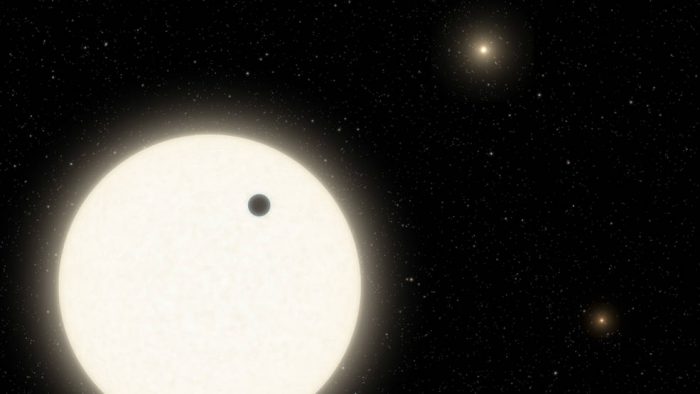In 2009, NASA launched a spacecraft that would go on to change how we view space. The Kepler Space Telescope.
It is now retired. But when it was launched, Kepler was more than just a powerful telescope. It was a planet hunter. Its core mission was to discover whether or not any stars out there had planets around them, like our star, the Sun, has Earth and the other planets in our solar system, around it.
Planets outside our own solar system are known as exoplanets. And guess what? Kepler found thousands of them out there!
We've written about a few of these exoplanet discoveries in the past. But the latest might be the coolest of them all. An exoplanet 1,800 light years away called KOI-5Ab that exists in a three-star system. Yep, three stars!
Triple play

A graphic showing the approximate orbits of the three stars in KOI-5, along with its planet, KOI-5Ab. (IPAC)
The three-star system features the stars KOI-5A, KOI-5B, and (wait for it...) KOI-5C. A was the first star to be confirmed—it wasn't until 2014 that B and C were added to the system. Two-star systems are actually very common in the universe. Some studies suggest that they may actually be the most common type of solar system out there.
But they're also more difficult systems to confirm planets around because distant planets don't reflect enough light for us to see them on their own. We can only see them when they move in front of their star, which causes the star's light to dim just a little. But if there's more than one star in a system, being sure that the dimming of a star is because of a planet is in front of it is much harder to do. And it is a big part of the reason why KOI-5Ab took so long to be confirmed.
Sorry to forget about you
Though astronomers have only just made this announcement, KOI-5Ab was discovered by Kepler back in 2009. So why the delay?
To put it simply, it got buried under the avalanche of information that Kepler was giving astronomers. It seemed like every day was bringing new possible exoplanets, and many of them were easier to confirm than KOI-5Ab. In the end, it wasn't until after Kepler was retired and was replaced by the TESS craft (Transiting Exoplanet Survey Satellite) that the exoplanet was finally confirmed.
In the end, the KOI-5 system is a complex and striking one. KOI-5Ab orbits star A closely. Star B is locked in a dance with Star A, meaning it would appear more distant from the planet, but would also grow larger and smaller depending on the time of year. Meanwhile, star C orbits the central pair very distantly.
What a cool addition to the long list of exoplanets and systems found by Kepler! You can learn more about all this in the NASA video below. Oh, and in case you're wondering why all the exoplanet names start with K .... it's in honour of Kepler, the cool craft that discovered them. Thanks, Kepler!
 An artist's illustration of the KOI-5 three-star system. KOI-5A is the main star, with the new exoplanet—KOI-5Ab—orbiting across its face. (NASA)
An artist's illustration of the KOI-5 three-star system. KOI-5A is the main star, with the new exoplanet—KOI-5Ab—orbiting across its face. (NASA)










wow this is realy interesting how there are planets a long way away that idk about